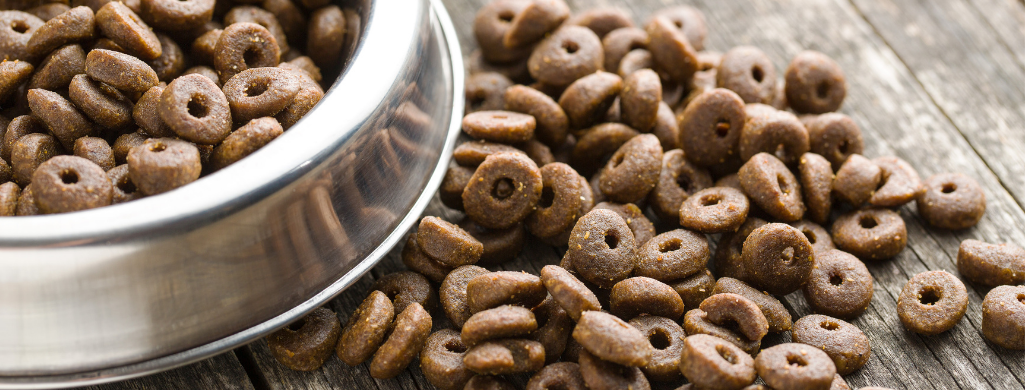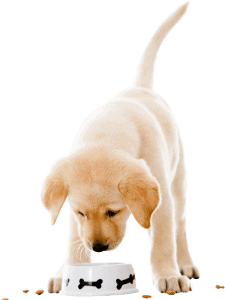
Yes. Dry dog food can go bad. Eventually. The question is how long does it take to go bad?
Don’t worry, it’s not a silly question. As a vet, I get asked this all the time.
Of course, wet dog food goes bad much quicker than dry dog food. But dry food will eventually go bad too.
Keep reading if you want to learn:
- How long dry dog food lasts?
- What causes spoilage?
- Why your dog should avoid food that’s gone bad?
- How to tell if dry dog food is bad?
- How to store dry dog food?
- What to look for when buying dry food?
How Long Does Dry Dog Food Last?
Dry dog food was invented for convenience and for shelf life.
The very act of removing moisture from dog food is one of the major factors that will help dog food not go bad.
There are also a number of preservative substances that help prolong a dry dog food’s shelf life. These preservative substances can be classified into natural and artificial.
These play a role in extending the expiration date of your dog’s food.
Anti-oxidants like vitamins and certain minerals can also help food storage and also serve to keep your dog healthy and to stop free-radical-dependent processes such as fat rancidity.
Some common terms to keep in mind when choosing your dog’s food are “best before / best by” and “expiration date”.
The best by date indicates a date by which the flavor profile, nutritional value (eg. vitamins), color, and smell of the food should be expected to not be altered. A bag of food past its best by date is not optimal but is still perfectly safe for your dog to eat.
On the other hand, the expiration date indicates a date by which the food is reasonably expected to have degraded.
Food past its expiration date is no longer safe from spoilage as the preservatives would have degraded by that time.
We advise not to feed such food to your dog.
Keep in mind that best by and expiration dates refer to the unopened bag- most dry dog food formulations will go bad after just a few weeks once the bag is opened or torn.
Always make sure that your dog’s food bag is not damaged and well-sealed.
Dog food in intact food bags is usually expected to last more than 12 months.
However, shelf life highly depends on the ingredients used in the diet.
Can Dry Dog Food Go Bad? What Causes Spoilage?
The processes involved in producing dry dog food kill off most bacteria and fungi. Then what causes dry dog food to go bad?
Unfortunately, once opened, nothing is stopping their recolonization efforts beyond the preservatives (natural or synthetic), which, as we discussed earlier, don’t last forever.
Holes in food bags are often the routes by which these bacteria and fungi can repatriate onto your dog’s food. Holes are also a route for air and moisture that they depend on.
Air exposure allows for oxygen-hungry aerobic bacteria to multiply. These can produce toxic byproducts and speed up fat oxidation.
Moisture can also find its way into the bag making a great environment for fungi (and bacteria). Even if you think the food in the bag is not wet, your so-called “dry food” actually contains up to 14% water.
Any increased moisture can lead to a greater water activity, allowing fungal and microbial colonization to happen.
Last but not least, high environmental temperature accelerates both microbial growth and fat rancidity.
Preservatives can only prevent all these processes until the dry dog food’s best-by date. After that, the food will start degrading.
After the expiry date (or some weeks after opening), the dog food’s nutritional content is highly compromised and it might also contain potentially hazardous substances.
As some studies pointed out, rancidity accounts for most of what we consider dry pet food spoilage and therefore lower fat diets usually have a longer shelf life.
Avoid quick spoilage by using diets lower in fats, however, always make sure that the diet you choose is still meeting your dog’s fat requirements.
Why Is It Bad for Your Dog to Eat Expired Food?
It is bad for the same reasons that you shouldn’t eat food that has gone bad.
The most common symptoms caused by dog food that has gone bad are vomiting, diarrhea, and flatulence. More serious symptoms include paralysis, hemorrhagic enteritis, and other intestinal conditions.
This is because of the bacteria, bacterial by-products, and the toxins (ex. Botulism C1 toxin) and mycotoxins that would have accumulated inside it.
Rancid fats are also carcinogenic. This is because the process of rancidity produces free radicals: unstable atoms that can enter cells and damage DNA, causing cancer.
Normally, these atoms are captured by antioxidants. When dog food expires, there are no more antioxidants in it to stop this process.
Aside from cancer, rancidity also decreases biotin (Vitamin B7) levels in the food which can cause a biotin deficiency in your dog.
How to tell if dry dog food is bad?
Follow these easy steps to tell if your bag of dog food is spoiled.
- Look at the bag and at the food. Does the food contain mold or bugs? Is there moisture condensation inside the bag? Trust your eyes.
- Smell the food. Does it smell “off”, rancid or acidic? If yes, there is a good chance the dog food might be rancid.
- Does your dog seem suspicious of the new food? Your dog’s nose knows! We advise you to take a whiff from the bag and closely inspect the food in that case.
- Does the food feel excessively greasy or moist to the touch?
- Check the expiry date of the food again.
- In the future, write on the bag the date you opened your bag of food. This will give you an idea if your food bag was opened for too long.
If anything is wrong with the food, take it back immediately. You should not be paying for food that could potentially harm your dog.
Food Storage Methods
There are a number of storage methods you can use.
We recommend keeping dog food in its original bag. Make sure to push the air out of the bag and close the bag as airtight as possible.
Certain brands make airtight ziplock dog food bags which will make your life simpler.
Some people keep dog food in a storage container. Unfortunately, this will not allow you to squeeze the air out like in a food bag.
It will also not allow you to see the nutritional information, expiry date, and batch number at a glance unless you keep the bag (the batch number is particularly important in case of recalls).
You will also need to wash the container each time you fill it since oil from previous food will go rancid and spoil the new food. The best solution is to keep the food in the bag, closed in the container.
Freeze some of the food if your dog will take a couple of weeks to finish the bag. Freezing dry dog food will prolong shelf life.
Keep out of the sunlight. Sunlight will make the food hot and cause more rancidity.
The above tips should be enough to keep your dog’s food tasty and edible for a few weeks after opening the sealed bag.
Tips for Keeping Dry Dog Food Fresh
We suggest you follow these simple rules:
- Buy only as much food as your dog can go through in a few weeks.
- Keep the food in the original bag, squeeze the air out, and seal well (eg with a clip, wire, or elastic.)
- Put the bag inside an airtight container.
- Use steel, as this is most hygienic.
- Only use glass if you can keep out of the light.
- Use plastic, if you’re prepared to clean it thoroughly.
- Don’t mix the new food with old food. Always finish the old food bag before opening a new one unless you are changing your dog’s diet.
- Always clean the container between one food bag and another. Rancid oils will cause a chain reaction in your new food and will make it spoil much faster.
- Always let the container dry completely after cleaning.
- Keep it in a cool, dry place, away from insects and rodents.
- Freeze a portion of your food if you have too much.
By following these few simple rules, your dog’s food will last longer and be safer.
Observing basic standards and using some common sense can go a long way. Always ask yourself if you would feed it to your kids if it was their food.
What to Look For When Buying Dry Dog Food?
When buying dog food, make sure to look at the best-by and expiry dates. How close is the expiry date to when you expect your dog to finish it?
Read the food labels and check for preservatives. I suggest choosing food with non-synthetic preservatives if you think that your dog will eat through the bag in less than 3 weeks.
If not, synthetic preservatives usually give food longer shelf life, and while you might find this to be questionable, synthetic preservatives will likely cause less harm to your dog than rancid or spoilt food.
If you want your dog’s food to have a long shelf life and have no preservatives we suggest you switch to a complete wet food diet. For more details on switching, see our article on wet vs dry dog food.
Also, always follow the storage instructions on the bag, these instructions will be the best instructions for that specific food. Don’t buy food in bulk unless you can freeze it or get through it in time.
The Bottom Line
Your dog is part of your family and you shouldn’t feed your dog bad food, just like you wouldn’t do that to your kids.
Food is something that affects your dog every day, and bad food can have a cumulative effect over time.
A little bit of attention and cleanliness can go a long way to protect your dog’s health.

